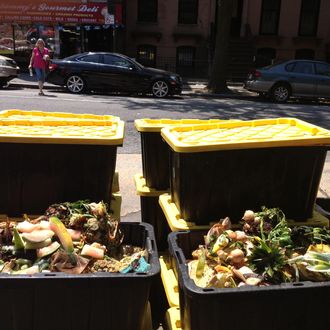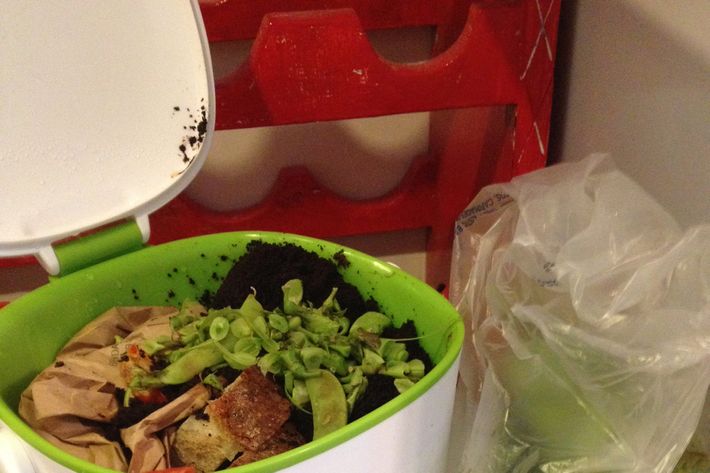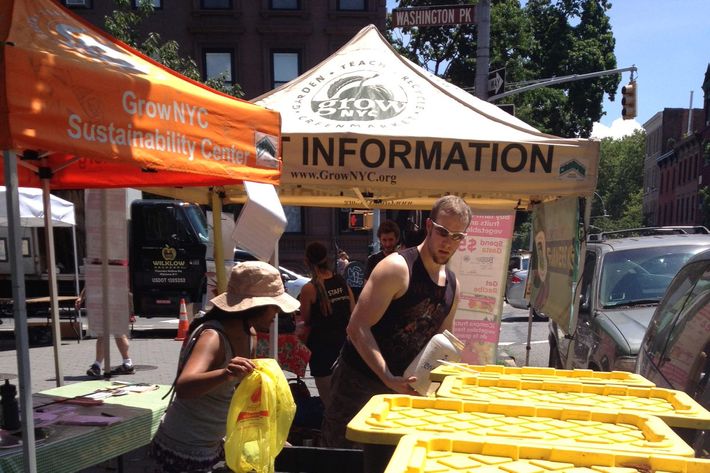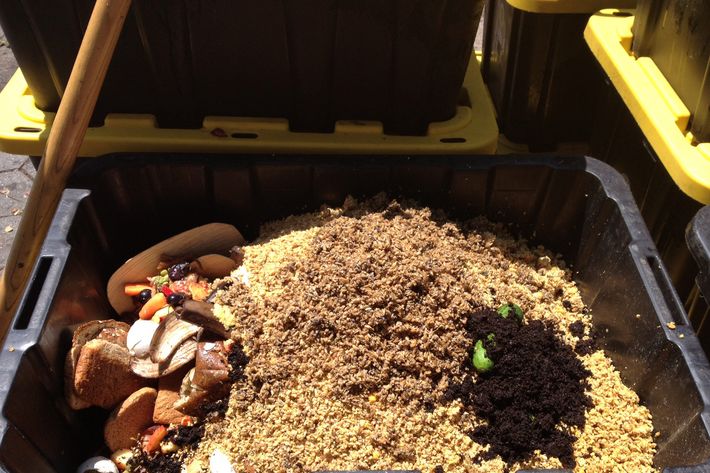
The incessant creation of garbage is a fact of human, and especially urban, life and begets the never-ending question of what to do with it all. Fewer and fewer of us feel comfortable just seeing it all trucked to a pit in some less-fortunate place. So we make new laws and learn new ways to sort it. Mayor Bloomberg’s latest move, as he heads into his final months on the job, is the institution of a food-waste recycling program that would require city residents to separate out their food scraps for collection, and composting, by 2016. It’s not an unheard-of effort. Seattleites and San Franciscans have been doing this for years. Some New Yorkers already bring their scraps to pilot programs run by the Department of Sanitation.
But any new city requirement — anything new in the city at all, really — is bound to get people talking, and talk they have. Among the nearly 1,000 comments posted to the New York Times piece announcing the new program, there are plenty of complaints, ranging from worries about rats, bugs, and odors to concerns about logistics, not to mention a clear aversion to being told what to do. As Eric Jaffe writes at Atlantic Cities, “When New York officials announced a plan for a citywide composting program a couple weeks ago, much of the negative response could be summarized with the word ick.” “The vermin and insect problems will be immense,” says one commenter on the Times article, while another adds, “I can’t even imagine how awful it will smell.” Building supers — at least those to whom the Daily Beast’s Samantha Guff spoke — shared those concerns. “And have more rats running through the streets? It’s ridiculous!” said one of them. But New York City politicians are presenting a pretty united front in favor of the move, and Ron Gonen, New York’s deputy commissioner for recycling and sustainability, has said, “We actually expect it to reduce odor issues and actually reduce vermin issues in New York City.”
So, how well-founded are the complaints? How difficult is composting, really? As a single person living in a tiny studio apartment where my only “outdoor space” involves opening the window and looking out, I sought to find out over the course of a ten-day trial period.
DAY 1: Thursday First, I had to figure out what I needed to do with my food scraps other than just throwing them in the trash and forgetting about them. I had seen the GrowNYC composting bins at my local Greenmarket and had the vague idea that I could drop stuff off there. But what, how, when, and what else did I need to know? After studying up a bit, I formulated a plan that was pretty basic: collect household food scraps in some sort of container for the week and, on the weekend, take them to the Greenmarket at a nearby park for disposal. The waste would then go to “one of several NYC compost sites to be transformed into a fertile soil amendment for use on local urban farming and gardening projects.”
As for what, there was to be no meat, poultry, fish, or greasy stuff, like fat or dairy products. Though technically those scraps can be composted, they tend to smell bad and attract vermin, so urban compost etiquette forbids it. The site warns against coconuts (I made a note to myself to find out why). Carbs and produce as well as eggshells, nuts, plants, and coffee grounds, however, are fair game. As are “hair and nails (animal or human),” per the Lower East Side Ecology Center. Oh my. I’ve purchased an OXO composting pail for $20 to make things official, even though you can easily keep scraps in an empty yogurt container or even just a bag in the fridge or the freezer. Cold storage is recommended to limit smells, especially in the heat of summer. I open my pail and start putting stuff — coffee grounds and some fruit and veggie discards — in. Whee.

DAY 2: Friday Hearing of my project, a friend mentions someone she knows who attempted to do “the worm bins” (she says ominously) at home. I’m really just collecting scraps and letting someone else compost them, which is what Bloomberg’s program would require. Vermicomposting is out of my league, a more complex method of composting by which you set up bins of worms that compost your trash for you. You can, in fact, do this in New York, and the city will help you do it.
There is no way in hell I’m willfully bringing worms into my apartment, but I figure I should find out what might happen if I did. I call Kelly, who’s in the process of packing to move to West Virginia, where she’s moving in with a man who has a composting toilet. “Holy shit!” I say. “Literally!” she says, before launching into her tale of worm woe, which began in the summer of 2009. She and some roommates in Astoria decided to try their hands at vermicomposting. The troubles they encountered were many. First, a number of the worms escaped to the floor, where they dried out and died.
The roommates then set up an electric fan to cool down those that remained, but found the dirt was too dry. They misted the dirt, and it got too wet and moldy. The worms didn’t want to break down the scraps. And then came the mites. “The experiment lasted less than a month,” she says. “I have a lot of admiration for the folks who brave it with the worms. It’s just not for me.”
DAY 3: Saturday I put my composting pail, which is about half-full, into my tote bag and head to the Greenmarket. There’s a polka band playing right near the composting bins, into which people are happily dumping their food waste from plastic bags and pails like mine. One man has a professional composting machine he’s brought to dump scraps from. The friendly GrowNYC volunteer points it out to me: “He must have had extra he couldn’t use on his own garden,” he says, and then tells me euphorically of how little kids come with food scraps to add to the bin and “are so proud.” I’m a little bit moved.
I pour in my compost, and he uses a tool to help me get the remaining waste out of my pail. He’s also got a large shovel for compost turning and at one point steps in the bin to crush it down and make room for more. “The easiest thing to do is keep stuff in a paper bag in the freezer and throw it right in the bin,” he advises. I lean in and smell the bins. It’s actually not bad; a little sticky, a little sweet — the slight edge of rotten. I’ve smelled way worse emanating from the garbage cans on the street.
DAY 4: Sunday As I enjoy my morning coffee, I Google “compostcate,” a Tumblr that makes food scraps look like art recommended by the guy at the Greenmarket. Then I go through the various brochures he gave me. I learn that I can “become a master composter,” which requires 18 to 23 hours of classroom instruction. I learn that “the average NYC household discards 1.3 pounds of food and yard waste a day,” which adds up to “more than 750,000 tons a year.” I learn that composting can recycle valuable organic nutrients, as well as limiting greenhouse gas emissions.
That night, after drinking too many wines, I come home and tweet, “A broken heart should be composted … Right?” Responses from around the Internet include “Trendy thing is to get it fixed in a local shop by artisanal, cruelty-free mechanics” and “No organ meats in compost sorree :(.”

These people clearly know what’s up.
DAY 5: Monday I contact Kate Blumm, communications manager at Brooklyn Botanic Garden, that borough’s host of the Department of Sanitation’s NYC Compost Project. Like the Lower East Side Ecology Center, the Western Queens Compost Initiative, and GrowNYC, the Botanic Garden works with the city on community outreach and education. She recommends a book called Easy Compost as a resource for composters in urban centers. “It can seem like a dirty, smelly, why are we doing this sort of thing,” she tells me. People say “ew,” but “on the most basic level, it’s really just about getting a receptacle. You say that and see the eureka go off in their head.”
After our conversation, I check my compost pail, where the scraps are nicely chilled and smell like coffee.
DAY 6: Tuesday I talk to Christina Salvi, assistant director in the Office of Recycling Outreach and Education at GrowNYC. “People thinking composting is going to be stinky or messy is one of the prime challenges we face,” she tells me, reiterating Blumm. “They have the food scraps, we collect them, but what happens in between is confusing. But it’s really pretty straightforward. I use Tupperware containers, but you don’t have to buy a fancy bin. We ask people to refrigerate or freeze their scraps because it cuts down on odors. My freezer is basically full of food scraps,” she confesses.
I learn from Salvi that the Union Square Greenmarket has hosted food-scrap collection since 1994, while GrowNYC has been around since 2007.

So where are all those scraps from the city’s dozens of drop-off locations — including 35 Greenmarkets — going? At first, the city’s food waste was sent to a composting facility about 100 miles away in Delaware, she tells me. Thanks to the efforts of GrowNYC and other groups, it now goes to local venues like the Gowanus Canal Conservancy and Red Hook Community Farm. When I ask, “What about rats?” she is unperturbed. “At my garden we had composting there for ten or fifteen years, and we only had a rat problem after construction,” she tells me. “You want to be careful about rat-proofing your compost. But I think there’s potential for it to reduce pests. The trash is there already; it’s in overflowing garbage cans. If people are really worried about pests, they need to waste less.”
Salvi also clears up the great coconut mystery: “Coconuts take forever to break down, and community composters who process scraps from Greenmarket can’t handle them.”
Day 7: Wednesday My pail is getting full. I add more coffee grounds and leftover salad that doesn’t have cheese and dressing on it. I throw in some old bread and a discarded paper bag. It seems like I might overflow the bin by Saturday, which may be a problem since my freezer is now full of Popsicles and we’re in the heat of summer. I lean in and breathe. Not bad! Nothing like the subway in August, or Broome Street.
Day 8: Thursday It’s the Fourth of July. I make coffee and dump the grounds in the increasingly full bin, then go out to eat potato chips and drink beer on a rooftop. On the way to the party I tell a friend I’m composting for a story. I tell him it could become mandatory. He says, “Screw that. I’m not going to do it.” I tell him it’s easy and fun. He looks dubious. “It’s garbage in your refrigerator,” he says. Of course, if and when composting becomes mandatory, there will likely be fines to incentivize folks like my friend, as well as possible central collection points in apartment buildings.
Day 9: Friday I make myself a tomato sandwich and put the scraps in the bin, along with the daily allotment of coffee grounds. Tomorrow I can drop it off at the compost station, and that’s good, because I am full up. My next step is to get better about buying amounts of vegetables I’m actually going to eat. I’m ashamed to say that the broccoli I so enthusiastically purchased the weekend before is now yellow, and the cucumbers are limp and mushy. Since my pail is full, I throw the rotting stuff in a plastic bag, along with some wilted lettuce, and stash it in my crisper. Later that night I make dinner using the still-good veggies in my fridge. I cut up a bunch of sugar snap peas (throwing the stems in the pail), sauté them along with a tomato, and add them to pasta with Parmesan. It’s a primavera! I feel borderline vindicated.
Day 10: Saturday While drinking coffee and getting geared up to go to the Greenmarket, I reflect. This little experiment has been good, I think. It’s made me feel less guilt-ridden about what I waste, even if it has made it all too clear that I waste a lot (and need to get better at that). There’s something soothing about putting scraps in a particular place and knowing they will go to do good and not bad in the world. And the process has made me think a lot more about what I consume, both in terms of quantity and quality. Unlike Kelly’s trial with the worm bin, the hard part has been largely confined to maneuvering the pail in and out of the fridge and remembering to put food waste in a new place. For a single, childless person who doesn’t cook terribly much and lives close to a park, it really couldn’t be easier. And maybe this is an utter coincidence, but I’ve seen more bugs in my apartment when I haven’t been composting.
Okay, yes, the vegetables in the bag smell a wee bit rotten, largely because they’ve been malingering for a week, but when I put my nose to the pail, it’s almost pleasant, with a hint of spiciness. To my great surprise, when I dump the scraps in the large compost bins at the Greenmarket right next to where doggy portraits are being shot in 90-degree heat, there’s not much of a smell, either. Frozen melons converge with my greens and coffee in lovely harmony, and everyone seems to be smiling. I head off into the sun, thinking, Composting is great! But worms? That’s where I draw the line.





























